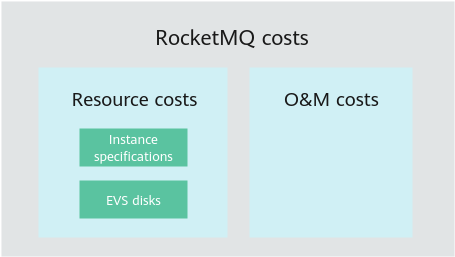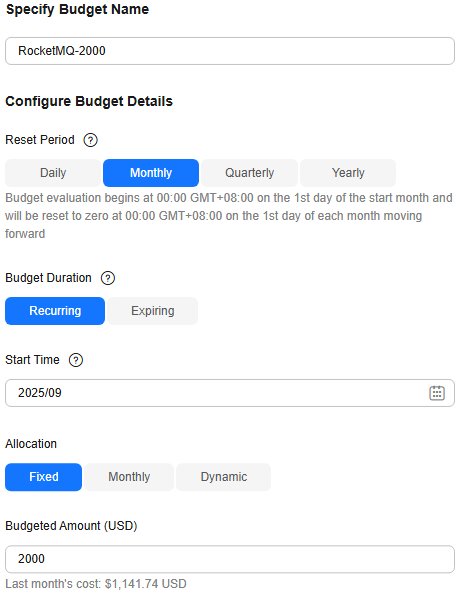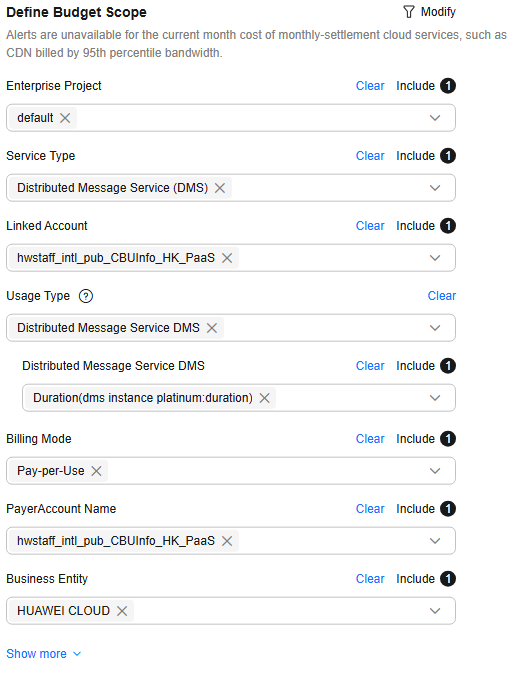Cost Management
Enterprises are paying more and more attention to the cost of using cloud. The following describes how to manage costs from four dimensions: cost composition, allocation, analysis, and optimization, to help maximize return on your investment.
Cost Composition
DMS for RocketMQ incurs two types of costs:
- Resource cost: cost of various types of resources (billing items of DMS for RocketMQ). For details, see Billing Items.
- O&M cost: labor cost generated during the use of DMS for RocketMQ.

Huawei Cloud Cost Center helps you manage resource costs with ease. However, you need to identify, manage, and optimize O&M costs by yourself.
Cost Allocation
A good cost accountability system is the basis of cost management. It ensures that departments, business teams, and owners are accountable for their respective cloud costs. Allocate costs to different teams or projects so that organizations have a clear picture of their respective costs.
Huawei Cloud Cost Center supports cost collection and reallocation with multiple tools for you to choose from.
- Allocate costs by linked account.
The enterprise master account can categorize the costs of its member accounts by linked account to manage the accounting of those member accounts. For details, see Viewing Costs by Linked Account.
- Allocate costs by enterprise project.
Before allocating costs, enable Enterprise Project Management Service (EPS) and plan your enterprise projects based on your organizational structure or businesses. Select an enterprise project for a newly purchased cloud resource so that the costs of that resource will be allocated to the selected enterprise project. For details, see Viewing Costs by Enterprise Project.
Figure 2 Selecting an enterprise project for a RocketMQ instance
- Allocate costs by cost tag.
Huawei Cloud assigns tags to your cloud resources so they can be sorted in different ways, for example, by purpose, owner, or environment. The following is the process of managing costs by predefined tags.
 Figure 3 Adding tags to a RocketMQ instance
Figure 3 Adding tags to a RocketMQ instance
For details, see Viewing Costs by Cost Tag.
- Allocate costs by cost category.
You can use Cost Categories provided by Cost Center to split shared costs. Shared costs include the costs for the resources (compute network, storage, or resource packages) shared across departments or the costs that cannot be directly split by cost tag or enterprise project configured for the resources. These costs are not directly attributable to a singular owner, and hence cannot be categorized into a singular cost category. In this case, you can define cost splitting rules to fairly allocate these costs among teams or business units. For details, see Allocating Costs By Cost Category.
Cost Analysis
To accurately control and optimize your costs, you need a clear understanding of what parts of your enterprise incurred different costs. Cost Center visualizes your original costs or amortized costs using various dimensions and display filters for cost analysis so that you can analyze the trends and drivers of your service usage and costs from a variety of perspectives or within different defined scopes.
You can also use Cost Anomaly Detection provided by Cost Center to detect unexpected expenses in a timely manner. In this way, costs can be monitored, analyzed, and traced.
For details, see Making Cost Analysis to Explore Costs and Usage and Enabling Cost Anomaly Detection to Identify Anomalies.
Cost Optimization
- Cost control
You can create different types of budgets on the Budgets page of Cost Center to track your costs against the budgeted amount you specified and send alerts to the recipients you configured if the thresholds you defined are reached. You can also create budget reports and Huawei Cloud will periodically generate and send to the recipients you configured on a schedule you set.
Suppose that you want to create a monthly budgeted amount of USD2,000 for a pay-per-use RocketMQ instance, and to receive an alert if the forecasted amount exceeds 80% of the budgeted amount.
Figure 4 Basic budget information Figure 5 Setting a budget scope
Figure 5 Setting a budget scope
For details, see Creating Forecasts and Budgets to Track Costs and Usage.
- Resource optimization
Cloud Eye helps you monitor resource usage, identify idle resources, and find opportunities to save costs. You can also identify resources with high costs based on the results of Cost Analysis and take optimization measures accordingly.
- Monitor resource usage and evaluate whether the current configuration is too high. For example, monitor the usage of CPU, memory, and disk.
- Detect idle resources to avoid waste. For example, detect unattached EVS disks and unbound EIPs.
- Billing mode selection
Different types of services have different requirements on resource usage periods and therefore require different billing modes to achieve the optimal outcome.
- For mature services that are stable for a long time, use the yearly/monthly billing mode.
- For short-term, unpredictable services that experience traffic bursts and cannot be interrupted, use pay-per-use billing.
- O&M automation
Huawei Cloud also provides various O&M products to help you improve O&M efficiency and reduce O&M labor costs. For example:
- Auto Scaling: Continuously maintain instance clusters across billing modes, AZs, and instance specifications. Use this service when there is a clear distinction between peak and off-peak loads.
- Resource Formation Service: Deploy and maintain resource stacks that contain multiple cloud resources and dependencies with a few clicks. Use this service when for delivery of the entire system and clone environment.
- O&M automation: Define a group of O&M operations as services to execute O&M tasks with ease. Use this service for scheduled O&M, batch O&M, and cross-region O&M.
Feedback
Was this page helpful?
Provide feedbackThank you very much for your feedback. We will continue working to improve the documentation.See the reply and handling status in My Cloud VOC.
For any further questions, feel free to contact us through the chatbot.
Chatbot





